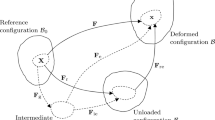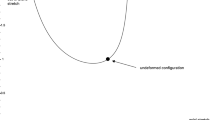Abstract
This paper generalizes previous work on physically based nonlinear orthotropic invariants for thermomechanical response of soft materials to include the inelastic process of homeostasis, which causes a biological tissue to approach its homeostatic state. This process of homeostasis can cause a homogeneous material (one with the same constitutive equations and material constants as each material point) to develop a nonuniform state. Within the context of biological tissues, this means that the tissue cannot be unloaded elastically to a zero-stress state. A simplified version of the theory is used to describe elastic response of an artery from its nonuniform homeostatic state using a Fung-type exponential orthotropic strain energy function with material constants determined for a human carotid artery. As discussed in Safadi and Rubin (Int. J. Eng. Sci. 118(40), 2017), the approach of assuming a homeostatic state at systolic pressure and limiting extrapolation of the constitutive response to the physiological pressure range reduces uncertainty in the stress distributions in the artery. The specific results here show that the circumferential stress in the physiological pressure range exhibits a strong sensitivity to residual stresses known to exist in the cut unloaded state. This approach suggests that detailed experimental data on the response of the artery in its physiological pressure range and more complete understanding of mechanobiological processes during homeostasis are essential for determining an accurate constitutive equation of an artery.








Similar content being viewed by others
References
Safadi, M.M., Rubin, M.B.: A new analysis of stresses in arteries based on an Eulerian formulation of growth in tissues. Int. J. Eng. Sci. 118, 40 (2017)
Humphrey, J., Rajagopal, K.: A constrained mixture model for growth and remodeling of soft tissues. Mathematical models and methods in applied sciences 12, 407 (2002)
Ateshian, G.A., Costa, K.D., Azeloglu, E.U., Morrison, B., Hung, C.T.: Continuum modeling of biological tissue growth by cell division, and alteration of intracellular osmolytes and extracellular fixed charge density. J. Biomech. Eng. 131(10), 2009 (2009)
Ambrosi, D., Ateshian, G.A., Arruda, E.M., Cowin, S., Dumais, J., Goriely, A., Holzapfel, G.A., Humphrey, J.D., Kemkemer, R., Kuhl, E., et al.: Perspectives on biological growth and remodeling. J. Mech. Phys. Solids 59, 863 (2011)
Ateshian, G.A., Morrison, IIIB., Holmes, J.W., Hung, C.T.: Mechanics of cell growth. Mech. Res. Commun. 42, 118 (2012)
Sciumè, G., Shelton, S., Gray, W.G., Miller, C.T., Hussain, F., Ferrari, M., Decuzzi, P., Schrefler, B.: A multiphase model for three-dimensional tumor growth. New J. Phys. 15, 015005 (2013)
Green, A.E., Naghdi, P.M.: A dynamical theory of interacting continua. Int. J. Eng. Sci. 3, 231 (1965)
Green, A.E., Naghdi, P.M.: A theory of mixtures. Arch. Ration. Mech. Anal. 24, 243 (1967)
Ateshian, G., Humphrey, J.: Continuum mixture models of biological growth and remodeling: Past successes and future opportunities. Ann. Rev. Biomed. Eng. 14, 97 (2012)
Hsu, F.H.: The influences of mechanical loads on the form of a growing elastic body. J. Biomech. 1, 303 (1968)
Cowin, S., Hegedus, D.: Bone remodeling I: Theory of adaptive elasticity. J. Elast. 6, 313 (1976)
Skalak, R.: Growth as a finite displacement field. In: Proceedings of the IUTAM symposium on finite elasticity, pp 347–355 (1981)
Skalak, R., Dasgupta, G., Moss, M., Otten, E., Dullemeijer, P., Vilmann, H.: Analytical description of growth. J. Theor. Biol. 94, 555 (1982)
Cowin, S.C.: Wolff’s law of trabecular architecture at remodeling equilibrium. J. Biomech. Eng. 108, 83 (1986)
Rodriguez, E.K., Hoger, A., McCulloch, A.D.: Stress-dependent finite growth in soft elastic tissues. J. Biomech. 27, 455 (1994)
Taber, L.A.: Biomechanics of growth, remodeling, and morphogenesis. Appl. Mech. Rev. 48, 487 (1995)
Lubarda, V.A., Hoger, A.: On the mechanics of solids with a growing mass. Int. J. Solids Struct. 39, 4627 (2002)
Volokh, K.: Stresses in growing soft tissues. Acta Biomater. 2(5), 493 (2006)
Kuhl, E.: Growing matter: a review of growth in living systems. J. Mech. Behav. Biomed. Mater. 29, 529 (2014)
Rajagopal, K., Srinivasa, A.: Mechanics of the inelastic behavior of materials—Part 1, Theoretical underpinnings. Int. J. Plast. 14, 945 (1998)
Eckart, C.: The thermodynamics of irreversible processes. IV. The theory of elasticity and anelasticity. Phys. Rev. 73(4), 373 (1948)
Leonov, A.I.: Nonequilibrium thermodynamics and rheology of viscoelastic polymer media. Rheologica acta 15(2), 85 (1976)
Rubin, M.B.: Plasticity theory formulated in terms of physically based microstructural variables - Part I. Theory. Int J. Solids Struct. 31(19), 2615 (1994)
Rubin, M.B., Safadi, M.M., Jabareen, M.: A unified theoretical structure for modeling interstitial growth and muscle activation in soft tissues. Int. J. Eng. Sci. 2015, 2015 (2015)
Rubin, M.B., Jabareen, M.: Physically based invariants for nonlinear elastic orthotropic solids. J. Elast. 90(1), 1 (2008)
Rubin, M.B., Jabareen, M.: Further developments of physically based invariants for nonlinear elastic orthotropic solids. J. Elast. 103(2), 289 (2011)
Rubin, M.B.: A new approach to modeling the thermomechanical, orthotropic, elastic-inelastic response of soft materials. Mech. Soft Mater. 1(1), 3 (2019)
Chuong, C.J., Fung, Y.C.: Residual stress in arteries. In: Frontiers in biomechanics, pp 117–129. Springer (1986)
Fung, Y.C.: What are the residual stresses doing in our blood vessels?. Ann. Biomed. Eng. 19 (3), 237 (1991)
Holzapfel, G.A., Gasser, T.C., Ogden, R.W.: A new constitutive framework for arterial wall mechanics and a comparative study of material models. J. Elast. Phys. Sci. solids 61(1-3), 1 (2000)
Holzapfel, G.A., Sommer, G., Auer, M., Regitnig, P., Ogden, R. W.: Layer-specific 3D residual deformations of human aortas with non-atherosclerotic intimal thickening. Ann. Biomed. Eng. 35(4), 530 (2007)
Holzapfel, G.A., Ogden, R.W.: Constitutive modelling of arteries. Proc. R. Soc. A Math. Phys. Eng. Sci. 466, 1551 (2010)
Humphrey, J., Eberth, J., Dye, W., Gleason, R.: Fundamental role of axial stress in compensatory adaptations by arteries. J. Biomech. 42, 1 (2009)
Safadi, M.M.: An Eulerian theoretical structure for modeling growth, remodeling and morphogenesis of soft tissues. Ph.D. thesis, Technion-Israel Institute of Technology (2016)
Emuna, N., Durban, D., Osovski, S.: Sensitivity of arterial hyperelastic models to uncertainties in stress-free measurements. J. Biomech. Eng. 140(10) (2018)
Flory, P.J.: Thermodynamic relations for high elastic materials. Trans. Faraday Soc. 57, 829 (1961)
Zeinali-Davarani, S., Choi, J., Baek, S.: On parameter estimation for biaxial mechanical behavior of arteries. J. Biomech. 42(4), 524 (2009)
Eddhahak-Ouni, A., Masson, I., Mohand-Kaci, F., Zidi, M.: Influence of random uncertainties of anisotropic fibrous model parameters on arterial pressure estimation. Appl. Math. Mech. 34(5), 529 (2013)
Heusinkveld, M.H., Quicken, S., Holtackers, R.J., Huberts, W., Reesink, K.D., Delhaas, T., Spronck, B.: Uncertainty quantification and sensitivity analysis of an arterial wall mechanics model for evaluation of vascular drug therapies. Biomech. Model. Mechanobiol. 17(1), 55 (2018)
von Hoegen, M., Marino, M., Schröder, J., Wriggers, P.: Direct and inverse identification of constitutive parameters from the structure of soft tissues. Part 2: dispersed arrangement of collagen fibers. Biomech. Model. Mechanobiol. 18, 897 (2019)
Keyes, J.T., Lockwood, D.R., Utzinger, U., Montilla, L.G., Witte, R.S., Geest, J.P.V.: Comparisons of planar and tubular biaxial tensile testing protocols of the same porcine coronary arteries. Ann. Biomed. Eng. 41, 1579 (2013)
Kamenskiy, A.V., Dzenis, Y.A., Kazmi, S.A.J., Pemberton, M.A., Pipinos, I.I., Phillips, N.Y., Herber, K., Woodford, T., Bowen, R.E., Lomneth, C.S., et al.: Biaxial mechanical properties of the human thoracic and abdominal aorta, common carotid, subclavian, renal and common iliac arteries. Biomech. Model. Mechanobiol. 13(6), 1341 (2014)
Acknowledgements
The author would like to acknowledge helpful discussions with MM Safadi and N Emuna.
Author information
Authors and Affiliations
Corresponding author
Additional information
Publisher’s note
Springer Nature remains neutral with regard to jurisdictional claims in published maps and institutional affiliations.
Appendix A: Details of some the mathematical expressions
Appendix A: Details of some the mathematical expressions
1.1 A.1 Details of the functions N i and A i
The scalar functions Ni and Ai in Eq. 26 are defined by
1.2 A.2 Details of the tensors \(\mathbf {B}_{i}^{\prime \prime }\)
The deviatoric tensors \(\mathbf {B}_{i}^{\prime \prime }\) in Eq. 26 are defined by
Rights and permissions
About this article
Cite this article
Rubin, M. Modeling orthotropic elastic-inelastic response of growing tissues with application to stresses in arteries. Mech Soft Mater 3, 5 (2021). https://doi.org/10.1007/s42558-021-00035-w
Received:
Accepted:
Published:
DOI: https://doi.org/10.1007/s42558-021-00035-w




